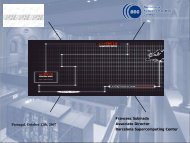e-Infrastructures Roadmap - Internet Society Nederland
e-Infrastructures Roadmap - Internet Society Nederland
e-Infrastructures Roadmap - Internet Society Nederland
- No tags were found...
You also want an ePaper? Increase the reach of your titles
YUMPU automatically turns print PDFs into web optimized ePapers that Google loves.
e-<strong>Infrastructures</strong> <strong>Roadmap</strong>Directions to: Software life cycle managementThe e-Infrastructure would be incomplete without software. Scientific software acts as a skeletalframework for many scientific developments, as its implements incremental knowledge, approaches,algorithms and models available. Often, specific scientific codes are used by dozens or even hundredsof groups and thousands of scientists across Europe and the rest of the world – with a life span ofsometimes several decades. The software is in some areas – where complexity has risen to the pointthat researchers cannot but depend on the validity and accuracy of the code – becoming the mostimportant carrier of scientific insights.There are two realms of codes: the first is owned by privately or publicly held companies, and requiressignificant fees to use them. In a way these act as scientific publishers, incorporating the knowledgediscovered by others into the software. This creates a number of problems, one of which is that oneparty decides where innovation can take place, which architectures are supported and optimised for.In a grid environment such features are undesirable, as they shrink the available set of resources.People also tend to have the same problematic relationship as with more classical scientific publishers:since many scientists are dependent on the codes they run for maintaining their pace of publication,financially draining the community to the point of extortion is lying around the corner. CurrentIntellectual Property Right solutions are not in the interest of science. The only exit-scenario is torebuild from scratch as a community effort, which is very time-consuming as these codes have beenworked on for many man years and the internals of the software are unclear to outsiders. Even if someuser communities of non-public codes would embark on such a scenario, this would still requiremore support for them for the next few years. For others, leveraging the buying power of the jointEuropean users is essential.The second realm of code is the software that is in the purely scientific domain. Many software isspawned rather organically from small-scale initiatives – quite often individual PhD-projects. Manyof these codes have however outgrown their initial use and development scope, and the creators fallvictim to their own success. Individual research groups that are now responsiblefor maintaining thecodes – as good or as bad as possible – take considerable pride in providing such a service to thecommunity. But they cannot be expected to pay for the whole development for years or even decadesby themselves. At some point the software reaches a critical stage for their user communities: howdoes it continue to develop? Implementing other peoples algorithms, fine-tuning and optimising thecode for new user groups and software environments and debugging – in short keeping the code upto date and usable to all – lack the imaginative force of new discovery.Despite the importance of such codes and their widespread use, they often lack adequate developmentsupport or even a basic life cycle management infrastructure. It is not that people aren’t seeing theimportance of maintenance, optimisation and further development. On the contrary, but such activitiesare outside the scope of the basic funding structure and national orientation of most research fundingagencies. In fact, software costs – including those of commercial codes – are systematically off radar.That it is problematic is very clear, when we are about to enter an era where e-Science is to blossom.Solutions at the EU level are needed; software crosses boundaries and local solutions are inefficient.There are three scenarios: the first is to leave the software as is, and just let it loose on a large scale onthe e-Infrastructure. This will at best just maintain inefficiency, and thereby invisibly occupy resourcesequivalent to significant amounts of money. If no investments are made, the science behind the softwarewill suffer. At worst the community suffers from an accumulation of systematic programming errors,resulting in large scale scientific errors undetectable until someone does build another correctimplementation or version of the software. This is obviously penny-wise and pound-foolish.The second scenario is to commercialize all the individual software packages. This may pay for somehard needed initial changes and be economically sustainable in the future, but it is both hard todo from a legal point of view (since so far everything was built with public funds and with thecontributions of many) and would create other problems. Commercialising would for instance takeaway the code from the open source domain – which is important for progress as it allows scientificscrutiny and the discovery of errors on the one hand and enables innovative dispute on the other. Andof course it will bring about the problems described earlier as the software enters the commercialrealm: reducing the amount of architectures and software environments supported and deliveringscientists to the mercy of their software publisher.A third option would be to create some structural funds in order to have professional softwareengineers and scientists take the responsibility together for building, maintaining and consolidatingscientific code. This seems the best solution. After all, not all scientists are programmers.In both realms things are about to change because of the grid. In order to work in the newconstellation with the grid middleware and new devices being brought in, significant changes willhave to be made. We should leverage this, equivalent to the leveraging of the Y2K-situation that ledto a significant upgrade of legacy installed base in the last years of the previous millennium.26 27







